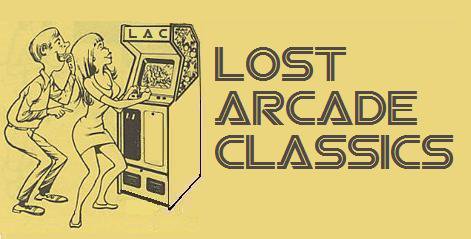

In lazy moments, I often daydream about arcades long gone. Whether I visited them almost every weekend like the Time Out arcade in Forest Village Park Mall, or only once, like the Orlando airport arcade (which featured a whole corridor lined with cabaret cabinets in ‘83), my photographic memory always serves me well.
I typically “walk” the entire arcade, piecing together the complete floorplan as I go, including the locations of most if not all of the games. Of these arcades, one of my favorites to “mentally revisit” is Pocket Change in Waldorf MD.
Opening in March 1990, Pocket Change was one of the initial storefronts in the St.Charles Towne Center Mall. The floor plan was basically an upside down reversed “L”, or, a Tetris piece, if you prefer. You entered the arcade at the long end of the L, which featured a remote control car track just inside the door on the left, and a counter where you cashed in tickets for cheap plastic items on the right. A little farther back were football throwing and basketball shooting games (I paid little attention to them), and a bank of skeeball machines. A cockpit Turbo Outrun sat in the center of this corridor, and behind it, several redemption pieces and a dollar bill changer.
The arcade then opened up into a truly cavernous room featuring a high ceiling, blue neon striping along the top of the walls, and a myriad of about 50 video games. Among the titles were Arch Rivals, Final Fight, Boot Camp, Super Monaco GP, Smash TV, Heavy Barrel, Galaga 88, Willow, and no less than EIGHT Teenage Mutant Ninja Turtles machines. The heroes in a half-shell were undeniably in their prime back then!
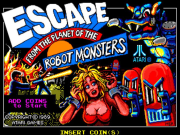 At that point, if you turned to the left and walked forward, you would find yourself in Pocket Change’s back corner, (the “short part” of the upside down L). Hidden along the back wall, you’d encounter a game that merged 1950’s sci-fi cinema campiness, with the artistic style of a 1970’s super hero comic book. It was a game with quite possibly the greatest name of any video game ever. That game, and this issue’s Lost Arcade Classic, was Atari’s Escape from the Planet of the Robot Monsters.
At that point, if you turned to the left and walked forward, you would find yourself in Pocket Change’s back corner, (the “short part” of the upside down L). Hidden along the back wall, you’d encounter a game that merged 1950’s sci-fi cinema campiness, with the artistic style of a 1970’s super hero comic book. It was a game with quite possibly the greatest name of any video game ever. That game, and this issue’s Lost Arcade Classic, was Atari’s Escape from the Planet of the Robot Monsters.
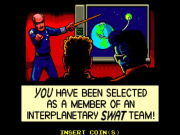 Robot Monsters (as I will call it from here on out) follows intergalactic S.W.A.T. team members Jake and Duke on a mission to a synthetic planet. Once there, they are tasked with freeing hostages and ultimately rescuing Dr. Sarah Bellum from a research facility overrun by the EEEEEEEEEEvil Reptilons and their metallic automatons.
Robot Monsters (as I will call it from here on out) follows intergalactic S.W.A.T. team members Jake and Duke on a mission to a synthetic planet. Once there, they are tasked with freeing hostages and ultimately rescuing Dr. Sarah Bellum from a research facility overrun by the EEEEEEEEEEvil Reptilons and their metallic automatons.
The player controls either Jake or Duke with a joystick and three buttons… fire, duck, and jump. Pressing all three buttons at once drops a bomb. A single player can play alone, or two players can play simultaneously.
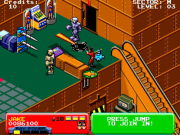 As the game begins, the player finds himself entering a large factory filled with old style computer terminals and other outdated equipment. A handful of “metal men” are wandering around rather aimlessly, but soon they spy our hero, and begin to lumber in his direction. These robots are slow, clunky, and uncoordinated, but they still pose a threat. Blast them for points and progress deeper into the facility.
As the game begins, the player finds himself entering a large factory filled with old style computer terminals and other outdated equipment. A handful of “metal men” are wandering around rather aimlessly, but soon they spy our hero, and begin to lumber in his direction. These robots are slow, clunky, and uncoordinated, but they still pose a threat. Blast them for points and progress deeper into the facility.
A little further in, you’ll encounter the “cyber guards”, flat faced, scowling orange robots that fire shots at chest level. To survive, you must either blast them before they fire, or duck under their shots. Cyber guards have a greater homing instinct than the “metal men”, but luckily, they are less populous. Touching either of these robots is not deadly, however, being at such close proximity means they can shoot you and you’ll have no time to react.
Blasted robots leave behind green power crystals. If you grab them before they disappear into the ether, your weapon powers up slightly. Grab enough crystals, and the power of your weapon advances through four colors shown on a small graph below your score. For instance, at the weakest ray gun level, yellow, the metal men take two shots to destroy. Once you’ve powered up to the next level, green, those same robots are felled with one blast. It’s easy to power up to green, but much more challenging to reach and stay at the pink or blue (most powerful) levels, due to the high number of crystals needed to reach them, and the fact that the ray gun’s power decays the stronger it becomes. As long as you grab crystals regularly, your laser will generally stay at the green level, which is more than enough to deal with most beasties.
Early on, it’s very easy to stand a few steps away from a cluster of robots, and just blast into their midst until only a bunch of green power crystals are left behind. This is a reasonable beginning strategy, but the game has a way of thwarting players who choose the easy way out. Standing in one spot for more than a few seconds, alerts the security orbs, highly caffeinated flying spheres that spastically launch bullets in multiple directions. The duck button enables you to safely stay below the orbs’ blasts, but starting on level two, the game summons drone carts that blast you at kneecap level, so your crouching position is no longer a safe sanctuary.
To ascend to higher floors within the complex, the player must locate the master switch that turns on the “Electro-stairs”, a fancy name for escalators. Walk up to the switch, and the character automatically throws it into the “on” position, causing the stairs to move up. Walk to the base of the Electro-stairs and take a ride to the next room. It’s unclear why our hero can’t simply ascend if they are turned off. Aren't escalators that are switched off simply stairs?
Yellow lockers can be blasted open to gain access to their contents, either food or bombs. Bombs are added at a rate of three to your inventory, and food increases your health by one block, for a maximum of three blocks of health. Getting zapped wastes a block, and once all health blocks are eliminated, that player looses a life. In an interesting twist, if the player already has three blocks (full health) when you munch some food, a spare man will be added into your reserve, but with only one block of health. Contrast this with the trend of nearly ever other video game of the era, in which nothing is gained if a full strength character grabs some food.
As you blast, duck, and dodge robots, don’t forget to rescue the human hostages! These poor men and women are being forced to operate the very machines and computers that run the Reptilons’ empire! Touch the captives to beam them to safety aboard your shuttle. Be careful with your ray gun, as hostages can be accidentally blasted. The first blast stuns them and makes them look like Wile E. Coyote after an Acme product backfires in his face. The second blast eliminates them completely, and you don’t want involuntary manslaughter on your record.
Most hostages are standing out in the open, although shackled to machinery, and forced to do menial labor. (hmmm… could this be Atari’s sly commentary on the tedium of jobs in the manufacturing sector?) Level two introduces captives “under glass”, that is to say, they are literally standing inside glass tubes. Release these hostages by locating the computer panel that controls the tubes. Destroy it, and the tubes lift, allowing you save the captives. An even later level features rows of hostages seated at desks, doing mundane tasks on computers. As somebody who has spent many years working in “cube farms”, I can say beyond the shadow of a doubt that I love saving these particular folks, and then blasting all the computers to oblivion! Damn it feels good to be a gangsta!
Periodically, wooden crates emblazoned with question marks appear throughout the level. Blasting a crate reveals its contents, which could be something cool like an extra hostage to save, or a delightful dinner, complete with elegant place setting and a glass of wine… or it could be more security orbs. It seems to be an even bet whether you’ll get something good or bad out of a crate, so I recommend blasting them all, and just deal with the orbs when they fly out. You’ll end up rescuing extra hostages and getting more points and health in the long run.
Other hazards include electric floor tiles that temporarily freeze the player, rotating sweeper bars that knock you down, spikes that violently stab across walkways, hyperactive red “metal men”, and robots with tank tread “feet”.
A final hazard is clumsiness. If you wander too close to an unprotected ledge, you may fall and end up holding on to the sides for dear life. Additionally, stepping in an oil puddle causes you to slip and fall. In both of these situations, our hero can be returned to safety (and an upright fighting position), by rapidly tapping the jump button.
Upon reaching the end of a factory, our heroes step into a “Port-O-Matic” vacuum transport tube to warp to the next level. The player can now take a few moments to rest as the heroes are rewarded and bonus points are totaled up for all rescued hostages. If 10 hostages are saved, (one shuttle load), a bonus block of health is added.
To progress to the next factory, our hero pilots a cyber-sled through a simple canal maze. The sled must be made of rubber, as crashing into a maze wall causes it to compress into an accordion shape and spring back to regular size, just like in a classic Warner Brothers cartoon. Three doors await at the end of the maze, leading to three different factory levels. Park your sled in front of one of the doors, and that’s the factory you’ll visit next.
The canal maze “mini-game” is a timed contest. You’ll gain bonus points for any unused time on the clock and an additional health block once you reach the three doors. If you don’t navigate out of the maze before the time ticks down, you progress to a randomly picked factory, and you receive no bonus points or health. This is a fun little level as there is no threat of loosing a life… just man the joystick and steer that little rubber spaceship through the canals!
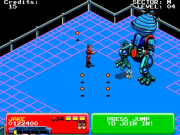 After another factory level, our hero then faces off against an evil Reptilon, a very peculiar creature resembling a cyborg Godzilla with a metallic clam shell for a head. The Reptilion’s primary method of movement involves rushing at you with a quick shuffling run, or simply to jump around, jump around, jump up, jump up, and get down, in order to stomp you flat. Bombs are the only thing that will take him down, so be prepared to use as many as possible. Once destroyed, he drops about 20 power crystals, which only last a few seconds, so grab all you can as a reward for a job well done!
After another factory level, our hero then faces off against an evil Reptilon, a very peculiar creature resembling a cyborg Godzilla with a metallic clam shell for a head. The Reptilion’s primary method of movement involves rushing at you with a quick shuffling run, or simply to jump around, jump around, jump up, jump up, and get down, in order to stomp you flat. Bombs are the only thing that will take him down, so be prepared to use as many as possible. Once destroyed, he drops about 20 power crystals, which only last a few seconds, so grab all you can as a reward for a job well done!
The remainder of the game follows the same pattern for several cycles… factory, maze, factory, Reptilon, factory, maze… until you ultimately rescue Dr. Sarah Bellum (years before she retired from science, and took up a job as a mayoral assistant in the City of Townsville – and no, I’m not serious about that). Personally, I was never able to rescue the good doctor, as the final Reptilon boss always stomped me HARD, and at that point the game no longer allows continues. NO FAIR!!! Still, it kept me coming back to try just one more time…
The graphics are quite unique, presented in an isometric view (think Zaxxon), and all of the enemies have a silly, not sinister quality reminiscent of the primitive “men-in-monster-suits” common in 1950s drive in features. Jake and Duke are each cast from the Buck Rogers or Flash Gordon sci-fi hero mold, and the factories are filled with artifacts of a bygone era like a mysterious spinning atomic symbol in a globe (which can be blasted), and clunky outdated computer equipment (which can also be blasted!)
Influence from comic books is seen in the overall bright color scheme, prominent black defining lines, and cut scenes showing Jake and Duke’s Commander speaking through a Dick Tracy styled TV watch with such dialogue as…
“Good job, now get to the next factory and rescue our people!”
Atari clearly wanted to make sure you heed the Commander’s words, as they are not only displayed in a spiky word balloon, but are also heard via the miracle of voice synthesis, for double emphasis!
Most of the voice synthesis is attributed to the Commander, who provides detailed instructions during the attract mode, and brief nods in between levels. Jake and Duke are limited to simple utterances such as “Yeah!” (when collecting crystals), “Uh-oh… WOAH!” (when hanging from a ledge) and various sounds of surprise and frustration when slipping on oil or being zapped by a robot.
The music tracks are upbeat and catchy, and compare favorably to the soundtracks of other games released in ’89 like Teenage Mutant Ninja Turtles, Super Off Road, and Atari’s own Tetris. (okay, maybe nothing is as catchy as Tetris music…)
Atari even equipped the Robot Monsters machine with fancy hall-effect joysticks that use magnetism to sense and interpret movement. These sticks afford the player a greater degree of precision control not encountered with standard 8-way joysticks.
The Robot Monsters machine at Pocket Change was a kit installed into a Williams’ Robotron: 2084 cabinet, and the interesting thematic similarity between those two games was not lost on me. At their core, both titles feature a player-controlled hero rescuing people from evil robots that are running amuck. There were other machines like this near me as well… another arcade featured a Front Line converted into Ikari Warriors, and a local billiards hall had a classic Breakout cabinet updated into an Arkanoid. It’s almost as if the operators made a conscious effort to keep the spirit of the older games alive by choosing kits that could be viewed as unofficial updates to the original title. I’m sure I’m reading way too much into it, and these conversions are just coincidences, but that’s what I do. I wonder about stuff.
I believed that Robot Monsters was a kit-only game until much later in the decade, when I got my mitts on a sales flyer proving that Atari actually released a dedicated cabinet. Since then, I’ve seen a few of the dedicated models, but they are certainly scarce. It shares the same overall shape as Klax, Relief Pitcher, Shuuz, and the 25” monitor version of Primal Rage, but it belongs to a sub-set of that cabinet style featuring oversized marquees with unique angles. These marquees are real attention grabbers, as their unusual shape allows for the artwork to expand beyond the confines of the traditional rectangular marquee. The Robot Monsters marquee displays one of the buxom female hostages on the left, shrieking in fear as the evil Reptilons leer at her from the right-hand side of the header. Between them, Jake mans a laser rifle and Duke lobs a grenade at the evil beasts. Other Atari cabinets using these oversized marquees include Badlands, Skull & Crossbones, and the two-player incarnation of Cyberball 2072.
And what became of Pocket Change? The frequency of my visits had seriously dwindled by the late 90s. Chalk it up to moving 45 minutes away, getting an apartment, and a “real job”. My last visit to date was in the summer of 2001, shortly after which I moved to Ohio. Research indicates that Pocket Change shut down in 2008, but reopened as “Game Over”, featuring pool tables, air hockey, and X-box 360 games. I’d like to think it looks the same inside, but I expect its been remodeled. Still, an 18-year run for an arcade opened well after the traditional “golden age boom” is rather impressive.
I have so many great memories of that place. When I worked a few stores away at Waves Music, my manager would often give me paid 20 minute “arcade breaks” when mall traffic was slow. He was a gamer as well, so when I’d return, he would leave to go play. I also befriended many of Pocket Change’s employees. One guy let me hang out there after they closed and play as they were vacuuming the floor, and I got the assistant manager hooked on collecting the Atari 5200, a system that she loved as a kid.
But repeatedly, when I daydream about Pocket Change, I find myself mentally lingering near the Robot Monsters machine, just like I did many moons ago. That very game that I could play undisturbed in the back corner for as long as I wanted, guaranteed. And in a hectic world, loosing your stresses for a little while in a world of Reptilons, SWAT members, canal mazes, security orbs, and indeed, Robot Monsters, is a great gift. A gift shipped across the miles and through the decades from the museum of the Lost Arcade Classic.